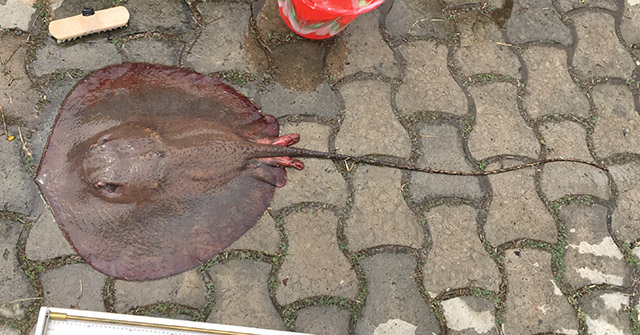| Dasyatidae (Stingrays), subfamily: Urogymninae |
| 120 cm WD (male/unsexed) |
|
demersal; freshwater; brackish, |
| Africa: rivers and lakes in western Africa (Ref. 81259, 81625). |
|
Vertebrae: 108-122. Diagnosis: Dasyatis ukpam is a very large and thick-bodied freshwater dasyatid (Ref. 26277). Entire dorsal surface of disc covered with stout-spined denticles, smooth in newborn (Ref. 26277). Sting greatly reduced in size or absent (Ref. 26277).
Description: A very large stingray with a thick and almost circular disc, with broadly rounded corners and about as wide as long, and a scarcely distinct snout (Ref. 81259, 81625). Disc oval, very thick; medial lobe narrow-based and short, its anterior margin broadly convex; disc depth 13.3-15.7% of disc width; dorsal surface of disc very rough, entirely covered with rounded or heart-shaped stout-spined dermal denticles, which are particularly concentrated on the centre of the disc (Ref. 26277, 81259). One or two pearly tubercles sometimes present, but especially an irregular mid-dorsal row of large, conical pointed thorny tubercles and a few similar ones scattered over the pectoralfins (Ref. 81259). Mouth slightly arched, with 38-46/38-48 rows of teeth set in a pavement pattern, and 4 or 5 elongated finger-like mouth papillae (Ref. 7397, 81259, 81625). Nasal curtain fringed along its posterior margin, eyes relatively small and slightly elevated, spiracles large (Ref. 81625). Pelvic fins almost entirely covered by disc dorsally (Ref. 81625). Total pectoral radials 142-149 (Ref. 26277). Tail long and very spiny, rather stout and circular in cross-section at base; sting reduced or absent, dorsal ridge absent and ventral fold reduced (Ref. 81259, 81625).
Colouration: Disc and pelvic fins dark brown or gray-brown above, without spots or prominent markings; belly white except for broad dark margins; tail blackish except for underside of its base (Ref. 26277, 81259, 81625). |
| Benthic species mostly in lakes and rives, found more than 240 km upstream from the sea (possibly also coastal). The life history and present status of populations in West Africa is unknown. Type specimens were born after capture of the mother; few specimens exist (Ref. 114953). Ovoviviparous (Ref. 50449). |
|
Critically Endangered (CR); Date assessed: 04 August 2020 (A2cd) Ref. (130435)
|
| harmless |
|
Source and more info: www.fishbase.org. For personal, classroom, and other internal use only. Not for publication.

